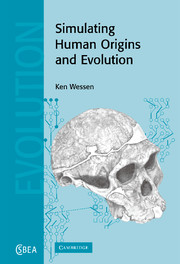3 - Simulation design
Published online by Cambridge University Press: 14 August 2009
Summary
The species simulation has two distinct parts. The first involves simulating the evolution of species and is described below. The second involves taking the evolved species, randomly designating some of them as fossils, and attempting a reconstruction of the phylogeny by using current species and fossils (Section 3.1.1) as well as a reconstruction based on Wagner distances (Farris, 1970; Wiley et al., 1991) that uses current species only (Section 3.1.2).
Each simulation starts with a single ancestral species that has a particular suite of morphological characters. This species is then evolved in discrete steps, each step corresponding to a single species generation, and the nature of the available changes at each step is controlled by various parameters as described below. Each species generation is referred to simply as a generation in the following, but this should not be confused with generations of individual members of the species: this simulation has no concept of individual members of a species. Similarly, the immediate ancestor of a given species is termed its parent species, and the immediate descendants are called child species.
In each iteration, the evolved species are subjected to the effects of mutation, migration, extinction and possibly interbreeding. The degree and manner of influence from each of these effects is controlled via a number of user-specifiable parameters.
Information
- Type
- Chapter
- Information
- Simulating Human Origins and Evolution , pp. 26 - 41Publisher: Cambridge University PressPrint publication year: 2005
